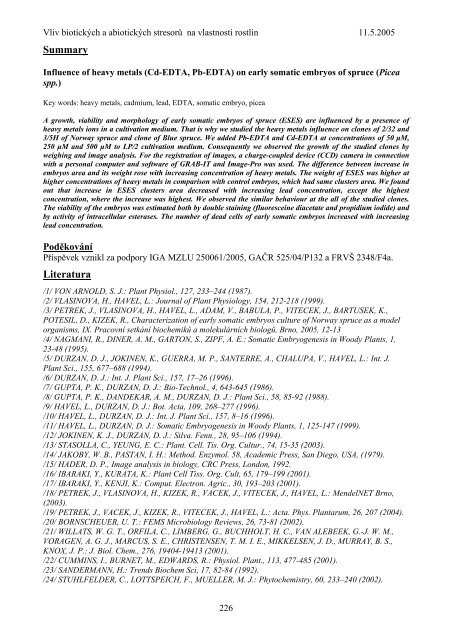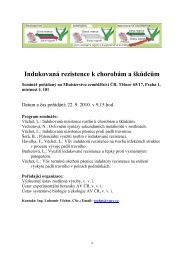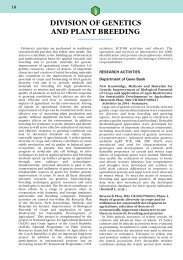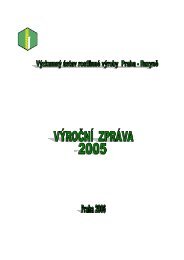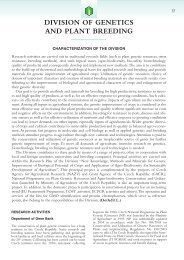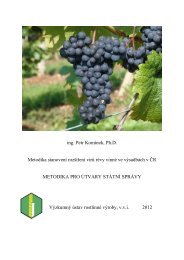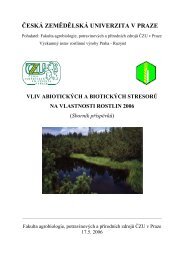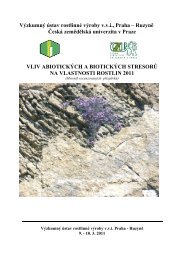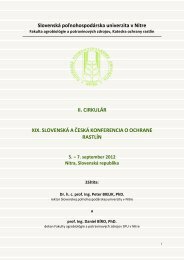LieÄÂivé rastliny v meniacich sa environmentálnych podmienkach
LieÄÂivé rastliny v meniacich sa environmentálnych podmienkach
LieÄÂivé rastliny v meniacich sa environmentálnych podmienkach
Create successful ePaper yourself
Turn your PDF publications into a flip-book with our unique Google optimized e-Paper software.
Vliv biotických a abiotických stresorů na vlastnosti rostlin 11.5.2005<br />
Summary<br />
Influence of heavy metals (Cd-EDTA, Pb-EDTA) on early somatic embryos of spruce (Picea<br />
spp.)<br />
Key words: heavy metals, cadmium, lead, EDTA, somatic embryo, picea<br />
A growth, viability and morphology of early somatic embryos of spruce (ESES) are influenced by a presence of<br />
heavy metals ions in a cultivation medium. That is why we studied the heavy metals influence on clones of 2/32 and<br />
3/5H of Norway spruce and clone of Blue spruce. We added Pb-EDTA and Cd-EDTA at concentrations of 50 μM,<br />
250 μM and 500 μM to LP/2 cultivation medium. Consequently we observed the growth of the studied clones by<br />
weighing and image analysis. For the registration of images, a charge-coupled device (CCD) camera in connection<br />
with a personal computer and software of GRAB-IT and Image-Pro was used. The difference between increase in<br />
embryos area and its weight rose with increasing concentration of heavy metals. The weight of ESES was higher at<br />
higher concentrations of heavy metals in comparison with control embryos, which had <strong>sa</strong>me clusters area. We found<br />
out that increase in ESES clusters area decreased with increasing lead concentration, except the highest<br />
concentration, where the increase was highest. We observed the similar behaviour at the all of the studied clones.<br />
The viability of the embryos was estimated both by double staining (fluoresceine diacetate and propidium iodide) and<br />
by activity of intracellular esterases. The number of dead cells of early somatic embryos increased with increasing<br />
lead concentration.<br />
Poděkování<br />
Příspěvek vznikl za podpory IGA MZLU 250061/2005, GAČR 525/04/P132 a FRVŠ 2348/F4a.<br />
Literatura<br />
/1/ VON ARNOLD, S. J.: Plant Physiol., 127, 233–244 (1987).<br />
/2/ VLASINOVA, H., HAVEL, L.: Journal of Plant Physiology, 154, 212-218 (1999).<br />
/3/ PETREK, J., VLASINOVA, H., HAVEL, L., ADAM, V., BABULA, P., VITECEK, J., BARTUSEK, K.,<br />
POTESIL, D., KIZEK, R., Characterization of early somatic embryos culture of Norway spruce as a model<br />
organisms, IX. Pracovní setkání biochemiků a molekulárních biologů, Brno, 2005, 12-13<br />
/4/ NAGMANI, R., DINER, A. M., GARTON, S., ZIPF, A. E.: Somatic Embryogenesis in Woody Plants, 1,<br />
23-48 (1995).<br />
/5/ DURZAN, D. J., JOKINEN, K., GUERRA, M. P., SANTERRE, A., CHALUPA, V., HAVEL, L.: Int. J.<br />
Plant Sci., 155, 677–688 (1994).<br />
/6/ DURZAN, D. J.: Int. J. Plant Sci., 157, 17–26 (1996).<br />
/7/ GUPTA, P. K., DURZAN, D. J.: Bio-Technol., 4, 643-645 (1986).<br />
/8/ GUPTA, P. K., DANDEKAR, A. M., DURZAN, D. J.: Plant Sci., 58, 85-92 (1988).<br />
/9/ HAVEL, L., DURZAN, D. J.: Bot. Acta, 109, 268–277 (1996).<br />
/10/ HAVEL, L., DURZAN, D. J.: Int. J. Plant Sci., 157, 8–16 (1996).<br />
/11/ HAVEL, L., DURZAN, D. J.: Somatic Embryogenesis in Woody Plants, 1, 125-147 (1999).<br />
/12/ JOKINEN, K. J., DURZAN, D. J.: Silva. Fenn., 28, 95–106 (1994).<br />
/13/ STASOLLA, C., YEUNG, E. C.: Plant. Cell. Tis. Org. Cultur., 74, 15-35 (2003).<br />
/14/ JAKOBY, W. B., PASTAN, I. H.: Method. Enzymol. 58, Academic Press, San Diego, USA, (1979).<br />
/15/ HADER, D. P., Image analysis in biology, CRC Press, London, 1992.<br />
/16/ IBARAKI, Y., KURATA, K.: Plant Cell Tiss. Org. Cult, 65, 179–199 (2001).<br />
/17/ IBARAKI, Y., KENJI, K.: Comput. Electron. Agric., 30, 193–203 (2001).<br />
/18/ PETREK, J., VLASINOVA, H., KIZEK, R., VACEK, J., VITECEK, J., HAVEL, L.: MendelNET Brno,<br />
(2003).<br />
/19/ PETREK, J., VACEK, J., KIZEK, R., VITECEK, J., HAVEL, L.: Acta. Phys. Plantarum, 26, 207 (2004).<br />
/20/ BORNSCHEUER, U. T.: FEMS Microbiology Reviews, 26, 73-81 (2002).<br />
/21/ WILLATS, W. G. T., ORFILA, C., LIMBERG, G., BUCHHOLT, H. C., VAN ALEBEEK, G.-J. W. M.,<br />
VORAGEN, A. G. J., MARCUS, S. E., CHRISTENSEN, T. M. I. E., MIKKELSEN, J. D., MURRAY, B. S.,<br />
KNOX, J. P.: J. Biol. Chem., 276, 19404-19413 (2001).<br />
/22/ CUMMINS, I., BURNET, M., EDWARDS, R.: Physiol. Plant., 113, 477-485 (2001).<br />
/23/ SANDERMANN, H.: Trends Biochem Sci, 17, 82-84 (1992).<br />
/24/ STUHLFELDER, C., LOTTSPEICH, F., MUELLER, M. J.: Phytochemistry, 60, 233–240 (2002).<br />
226


